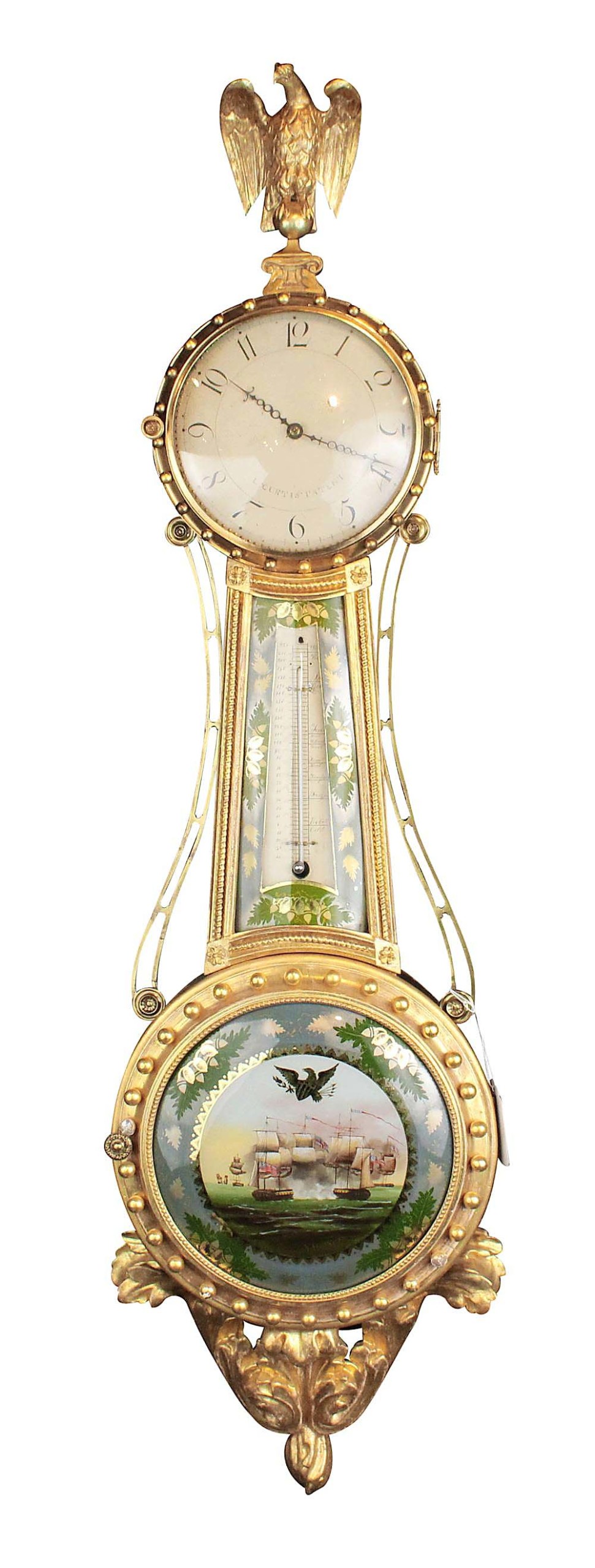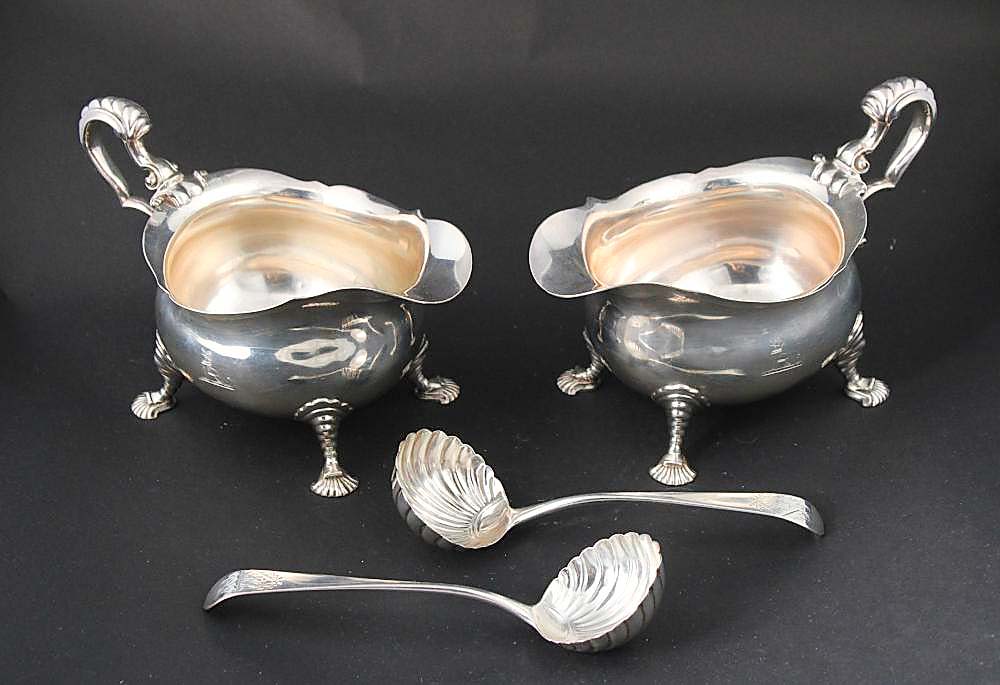
Ownership in two private collections and a prior auction were among the provenance noted for this Lemuel Curtis-made Federal eglomise and parcel gilt girandole clock that sold for $68,750 to a private collector through an agent bidding on their behalf. Andrew Holter said he was “really pleased” with the result ($15/30,000).
Review by Madelia Hickman Ring
BLOOMFIELD, N.J. — Nye & Company put traditional antiques and the Country House aesthetic in full focus on September 11-13, when it offered more than 950 lots of furniture, decorative arts and fine art, of which more than 300 lots were from the estate of Barbara Mallory “Bunny” Hathaway. More than 80 percent of the auctions gaveled down successfully, tallying more than $875,000 and exceeding the firm’s $750,000 aggregate low estimate. So, by the time we reached company president Andrew Holter, he had nothing but good things to say.
“The market showed great strength and diversity and I thought the sale did very well. The previews were very well-attended and we had a record number of new bidders and registrants, which is always encouraging.”
The Hathaway estate kicked things off with silver, achieving a session high of $22,500 for a pair of George III sterling silver sauce boats made in London in 1750 by Paul de Lamerie. Not only did the sauce boats bear a crest attributed to the family of Henry John Temple, the third Viscount of Palmerston, but they related to another pair in the collection of the Metropolitan Museum of Art. Another strong silver result — also from the Hathaway estate — was a Georg Jensen sterling center bowl in the Grapevine pattern, that brought $9,375.

Heading the Hathaway estate collection was this pair of George III sterling silver sauce boats made in London in 1750 by Paul de Lamerie. Accompanied by a pair of George III sterling silver ladles with shell bowls by John Hampston and John Prince of York, England, the lot topped off at $22,500 ($15/25,000).
The apex of the sale came 50 lots into the second day when a Federal eglomise and parcel gilt girandole clock, made in Roxbury, Mass., by Lemuel Curtis, finished at $68,750, more than doubling its high estimate. Consigned to sale by a private collector who had purchased it from Brunk Auctions in 2020, the timepiece, which depicted Perry’s victory in the War of 1812 in the circular lower section, sold to a dealer bidding on behalf of a client.
More early American furniture followed on the second day, much of which came from the same private collection as the Lemuel Curtis clock. Achieving the second-highest result of all at $23,750 was a Southern Queen Anne walnut dressing table that was attributed to Southwestern, Va., made between 1740-50. The catalog’s note referenced a MESDA file. Like the clock, it sold to a private collector via a trade agent bidding on their behalf.
A private collector, bidding for themselves, took a Southern Federal inlaid walnut and cherrywood bottle case to $22,500 to round out the leaderboard. Attributed to North Carolina or Virginia and dated to the early Nineteenth Century, the piece had been deaccessioned from the Bayou Bend collection at the Museum of Fine Arts, Houston, and had been published in David B. Warren’s Bayou Bend: American furniture, paintings, and silver from the Bayou Bend Collection (NY Graphic Society, 1988).

Prior history of this Federal inlaid walnut and cherrywood bottle case included the MFA, Houston’s Bayou Bend collection and two previous auctions as well as an Alabama private collection. Estimated at $15/30,000, it sold to a private collector for $22,500.
The focus shifted to Philadelphia furniture with a circa 1770 Chippendale dish-top tilt-top candlestand and a pair of Queen Anne walnut balloon seat side chairs, made 1750-70, which once belonged to Charles Eli Mendenhall, Jr., and had been handled by New York City dealer, Leigh Keno. Both sold to the same trade buyer who won them for clients, for $20,000 and $21,250, respectively.
Choice pieces of English furniture were also on offer and performed well. Leading the category was a stately George III carved mahogany library chair that had been reupholstered by Leroy Graves, the noted upholsterer at Colonial Williamsburg. Dated to the second half of the Eighteenth Century and with minor repairs, it exceeded expectations and went home with a trade buyer, who won it for $15,000.
Of slightly later age was a George III mahogany five-pedestal dining table from the Hathaway estate that extended 14 feet long. Surface distresses and wear justified its conservative $1/2,000 estimate but bidders liked its look and it closed at $8,125.
Also from the Hathaway estate, a pair of George IV walnut bergères, with caning on both the backs and seats and also with wear and surface distresses, exceeded expectations, bringing $4,688, nearly eight times the high estimate.

Some wear and distressing to the surface of this pair of George IV walnut and caned bergères only added to their appeal and they found a new home for $4,688 ($400/600).
There was more to the sale than furniture. A Japanese Meiji period bronze figure of a man holding a vessel — that stood more than four feet tall and was described as “monumental” — topped off at $11,875 and will be traveling across the pond to a buyer in the UK. A Chinese jade buckle magnifier that measured 10 inches long and was sold alongside a humidor decorated with three hardstones, achieved $5,000, the highest result of the third day of the sale.
The spotlight on American paintings shone on two very different lots. Crossing the block about halfway through the second day was a portrait of Queen Victoria painted in oil on canvas by Charles Cohill (American, 1812 to circa 1860), that was signed and dated 1856 and was a copy after a portrait of Queen Victoria done by Thomas Sully (American, 1783-1872). Cohill’s nearly life-sized portrait — it measured 91½ inches in height — sold to what Holter referred to as a “distinguished private collector” in Pennsylvania, for $6,250. It was followed across the block just a few lots later by “Figures and Shapes,” a mixed media on canvas geometric composition by Haywood Rivers (American, 1922-2002), that finished at $7,500.
While it was not one of the highest selling lots of American art, Andrew Holter particularly liked a watercolor view of General John Mason’s residence on Analostan Island that was painted by I. Farley in the Nineteenth Century. According to the catalog note, the image is a rare one, with another view of the house being in the Library of Congress. Mason was the son and youngest child of George Mason IV and built the home in the 1790s on the island that his grandfather had acquired in 1724. Holter confirmed it sold to an undisclosed institution, for $4,063.
Prices quoted include the buyer’s premium as reported by the auction house.
Nye & Company’s next sale will be October 23-24. For information, 973-984-6900, info@nyeandcompany.com or www.nyeandcompany.com.




















